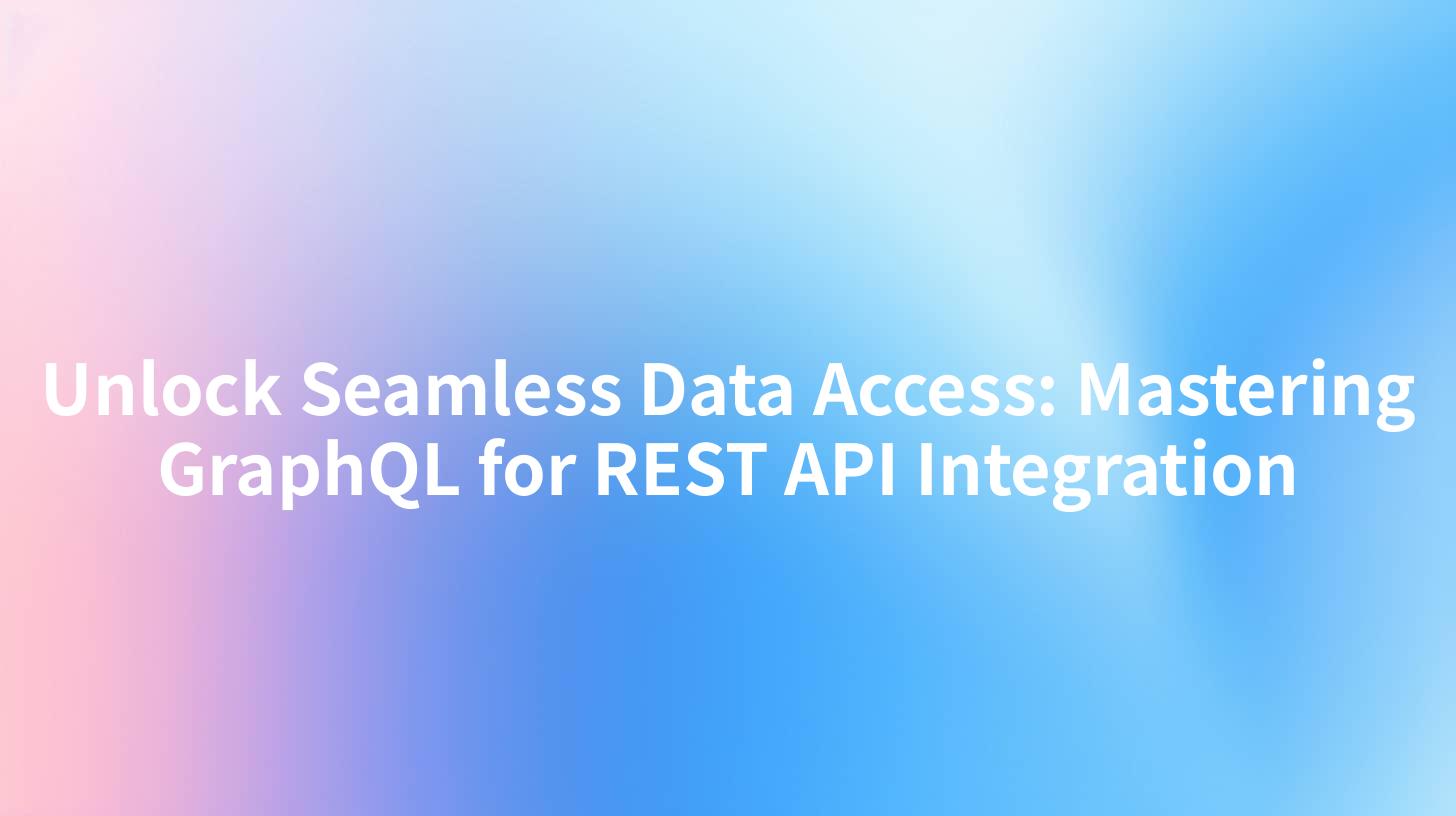Unlock Seamless Data Access: Mastering GraphQL for REST API Integration

Introduction
In the rapidly evolving landscape of web development, the demand for efficient and flexible data access has never been higher. Traditional REST APIs have been the backbone of web services for years, but they are not without their limitations. Enter GraphQL, a powerful query language for APIs that allows clients to request exactly the data they need, reducing over-fetching and under-fetching. This article delves into the world of GraphQL, its integration with REST APIs, and how to leverage both for seamless data access. We will also explore the capabilities of APIPark, an open-source AI gateway and API management platform, which can facilitate this integration.
Understanding GraphQL
GraphQL is a query language for APIs and a runtime for executing those queries with your existing data. It was developed by Facebook in 2015 and has since gained popularity for its ability to provide a more efficient and flexible way of interacting with APIs. Unlike REST, which uses HTTP methods like GET, POST, PUT, DELETE, GraphQL allows clients to request specific data fields directly.
Key Features of GraphQL
- Strong Typing: GraphQL uses a schema to define the types and relationships of data, which makes it easier to understand and maintain.
- Single Endpoint: Instead of multiple endpoints for different resources, GraphQL uses a single endpoint for all queries, which simplifies the client-side code.
- Query Flexibility: Clients can request exactly the data they need, reducing over-fetching and under-fetching.
- Error Handling: GraphQL provides detailed error messages, making it easier to debug issues.
APIPark is a high-performance AI gateway that allows you to securely access the most comprehensive LLM APIs globally on the APIPark platform, including OpenAI, Anthropic, Mistral, Llama2, Google Gemini, and more.Try APIPark now! 👇👇👇
Integrating GraphQL with REST APIs
Integrating GraphQL with REST APIs can be a powerful combination. While GraphQL provides the flexibility for data access, REST APIs can handle the CRUD operations for the underlying data sources. Here's how you can achieve this integration:
Steps to Integrate GraphQL with REST APIs
- Define the GraphQL Schema: Define the types, queries, mutations, and subscriptions in your GraphQL schema.
- Create Resolvers: Implement resolvers for each query, mutation, and subscription in your schema. These resolvers will fetch data from the REST API or other data sources.
- Set Up the GraphQL Server: Use a GraphQL server like Apollo Server or Express-GraphQL to set up your GraphQL API.
- Connect to the REST API: Use HTTP requests within your resolvers to fetch data from the REST API.
- Test and Iterate: Test your GraphQL API to ensure it works as expected and iterate as needed.
APIPark: Facilitating GraphQL and REST API Integration
APIPark is an open-source AI gateway and API management platform that can help you manage and integrate GraphQL and REST APIs. Here are some of the key features of APIPark that make it a valuable tool for this integration:
| Feature | Description |
|---|---|
| Quick Integration of 100+ AI Models | APIPark offers the capability to integrate a variety of AI models with a unified management system for authentication and cost tracking. |
| Unified API Format for AI Invocation | It standardizes the request data format across all AI models, ensuring that changes in AI models or prompts do not affect the application or microservices. |
| Prompt Encapsulation into REST API | Users can quickly combine AI models with custom prompts to create new APIs, such as sentiment analysis, translation, or data analysis APIs. |
| End-to-End API Lifecycle Management | APIPark assists with managing the entire lifecycle of APIs, including design, publication, invocation, and decommission. |
| API Service Sharing within Teams | The platform allows for the centralized display of all API services, making it easy for different departments and teams to find and use the required API services. |
Conclusion
Integrating GraphQL with REST APIs can provide a more efficient and flexible way of accessing data. APIPark, with its robust features and ease of use, can be a valuable tool in this integration process. By leveraging the strengths of both GraphQL and REST APIs, developers can build more powerful and responsive applications.
FAQs
1. What is the main advantage of using GraphQL over REST APIs? GraphQL allows clients to request exactly the data they need, reducing over-fetching and under-fetching, which can lead to improved performance and a better user experience.
2. Can GraphQL be used with any REST API? Yes, GraphQL can be used with any REST API. You would need to create resolvers that fetch data from the REST API and return it in the GraphQL schema format.
3. How does APIPark help in integrating GraphQL with REST APIs? APIPark provides features like quick integration of AI models, unified API format for AI invocation, and prompt encapsulation into REST API, which can facilitate the integration of GraphQL with REST APIs.
4. What are the benefits of using APIPark for API management? APIPark offers end-to-end API lifecycle management, API service sharing within teams, and detailed API call logging, which can enhance efficiency, security, and data optimization for developers and operations personnel.
5. Can APIPark be used for both open-source and commercial projects? Yes, APIPark is open-sourced under the Apache 2.0 license, making it suitable for both open-source and commercial projects. APIPark also offers a commercial version with advanced features and professional technical support for leading enterprises.
🚀You can securely and efficiently call the OpenAI API on APIPark in just two steps:
Step 1: Deploy the APIPark AI gateway in 5 minutes.
APIPark is developed based on Golang, offering strong product performance and low development and maintenance costs. You can deploy APIPark with a single command line.
curl -sSO https://download.apipark.com/install/quick-start.sh; bash quick-start.sh

In my experience, you can see the successful deployment interface within 5 to 10 minutes. Then, you can log in to APIPark using your account.

Step 2: Call the OpenAI API.


